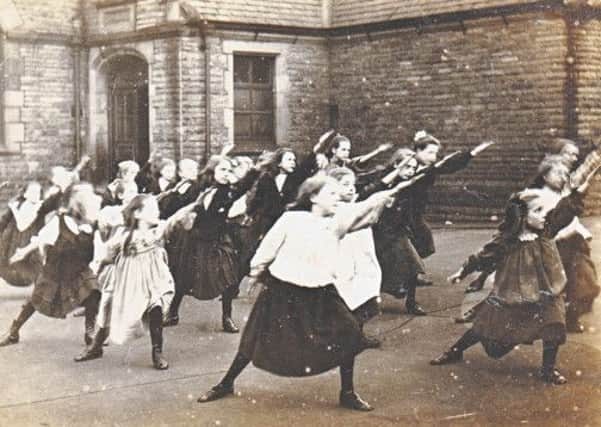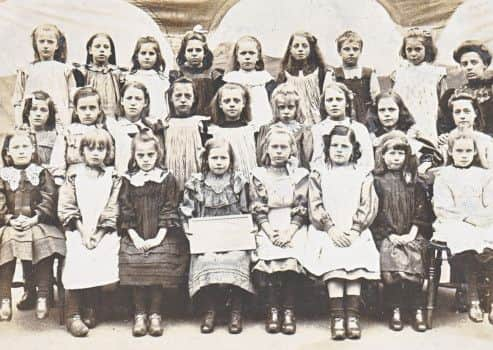How the Civic Trust saved an historic Burnley school


The first meeting of the Trust was held in March, 1964 but it has been decided to hold over celebratory events until late summer and autumn. The Trust will be publishing a booklet on Burnley’s 20th Century buildings, is to hold a lecture on the history and achievements of the Trust and other events will be advertised.
It is my intention to base the articles on some of the Trust’s most significant achievements. I have chosen a success which can be dated to the mid 1980s, the creation of the Burnley Wood Preservation Area and the listing of the former Burnley Wood School.
Advertisement
Hide AdAdvertisement
Hide AdIn fact, most of this article will be about the latter as unlike a number of other Burnley schools built at the time, Burnley Wood School has survived at least in part.


How this happened is largely the story I am to tell. However, I want to emphasise that, though Burnley and District Civic Trust, as it was then, can claim the preservation of the building as one of its successes, this achievement was only possible because of the involvement of local people.
These same people, and their descendants, have been involved, in recent months, in another, but unfortunately, less successful campaign, to preserve their much-used community centre.
Ironically, perhaps, this building was the gymnasium of the old Burnley Wood School, the subject of this article. It was one of the buildings that, after a considerable battle, 30 years ago, was not demolished. The gymnasium, it is thought, dated from about 1930.
Advertisement
Hide AdAdvertisement
Hide AdThe story of Burnley Wood School begins in 1870 though the building was not erected until 1892.
In 1870 the Elementary Education Act became law. It was an attempt to set up a national system of education. Under the Act School Boards were established in all places in which there was an insufficiency of school accommodation.
A few years later the attendance of children at school was made compulsory. In 1889 encouragement was given to technical education and, in 1891, elementary education was made practically free.
Before the Act of 1870, known as Forster’s Act, the provision of education, for poor children, was somewhat uneven.
Advertisement
Hide AdAdvertisement
Hide AdThere were schools for the sons (and to some extent daughters) of the relatively wealthy. In 1871, for example, before provisions of the 1870 Act had been properly implemented, there were nine private schools in Burnley which included the well-known Carlton Road School and three boarding schools.
In addition, there were no less than 23 public schools where “public”, unlike today, was understood to mean schools for the less well off.
Burnley Grammar School was one of these, though in some respects it does not fit in with the meaning of the word “public” as it was used then. Most of these schools were attached to churches, like Boot Street School, attached to St Peter’s, or Wood Top and Back Lane Schools, associated with Holy Trinity.
In addition there were schools for the Non-conformists, the most well-known being the Wesleyan School in Red Lion Street. The Catholics also had their school at St Mary’s in Eastgate, the old name for Yorkshire Street. There was also another category of school, the Sunday school, which met not only for religious purposes but delivered part-time education to the very poor.
Advertisement
Hide AdAdvertisement
Hide AdBurnley Council had little to do with these schools but the number of schools continued to increase. They remained Church Schools charging between 3d and 9d a week for attendance. Some of the better known include St Thomas’s (Catholic) which opened in 1876; North Street, 1879; St Mary Magdalene’s (Catholic), 1883 and Claremont, 1889.
By this time the changes in legislation mentioned above indicated that schools could no longer be left to the churches. In 1891 the first of the Board Schools at Abel Street was opened and, a year later, Burnley Wood School followed. Board Schools were provided by Burnley School Board which was not part of the council but these two schools indicated the way things were going to go at least in elementary education.
Burnley Wood School stood out from the early Board Schools. The others included Stoneyholme, 1896; Rosegrove, 1898; Coal Clough, 1900; Heasandford, 1903 and Hargher Clough, 1904 and most were designed by local architect Thomas Bell whose offices were at 14 Grimshaw Street, Burnley. He lived at 43 Ormerod Road.
However, Burnley Wood School was designed by London architect G.T.E. Lawrence. When compared with the other Board Schools it was much more impressive. The building originally contained two schools, a mixed school centred round the hall and an infants’ school centred round what is described on the plan as a marching corridor.
Advertisement
Hide AdAdvertisement
Hide AdThe school was well planned and ahead of its time by 10 or 15 years and had one feature which made the building of more than passing interest. This was the hall with its cast iron structure which is one of the earliest examples of metal construction used within a school building anywhere in the country. Added to this was the pyramidal lantern roof of the hall which, when built, was more impressive than it became in later years.
At the time of the First World War, this roof, one of several prominent roofs on the building, was altered losing some of its presence. In addition there were later extensions to the school which were the work of Thomas Bell but, sensibly, he virtually copied Lawrence’s work.
The building was, therefore impressive, at least more so than other school buildings constructed at the same time in Burnley. It was, though, part of the community of Burnley Wood, an interesting part of town which contained houses for some of the wealthy manufacturing families, homes for their managers and other professionals, together with houses for the poor.
Burnley Wood also sported a splendid Victorian church, St Stephen’s; a good chapel, a railway station, was near to Lower Towneley and the area contained a good shopping area together with several other interesting buildings. By the 1980s there was a demand from residents that the area be given Conservation Area status.
Advertisement
Hide AdAdvertisement
Hide AdIt was at this time that Burnley and District Civic Trust became involved and Miss Edith Corner, a member of the Trust, found herself in a leading role.
The Trust carried out its own survey which followed the 1977 publication of Burnley’s newly Listed Buildings.
The school had not been included in this and was not included in the Draft Burnley Wood Conservation Area which was published in February, 1985. However, after public consultation, in which the Trust was prominent, the boundary was extended to include the school in April of that year.
At the same time Lancashire County Council was considering what to do with Burnley Wood School. Part of it had been closed for a few years because it was deemed unsafe and, on February 18th, 1986, LCC applied to Burnley Borough Council for Listed Building Consent to demolish the building citing dry rot as the main reason.
Advertisement
Hide AdAdvertisement
Hide AdOn the same day, the Secretary of State included Burnley Wood School in the “List of Buildings of Special Architectural Interest or Historic Interest”. It was now not only in a Conservation Area: it had been individually “spot listed”.
The county council decided to proceed with its application to demolish the building and, as a consequence, Burnley Civic Trust registered a detailed objection. The battle lines were drawn up and the application was heard by Burnley’s Planning and Environment Committee in March, 1986. The committee supported the application and indicated it would prefer to see a new school building on the site.
In September of that year the committee, after hearing other options, reaffirmed its decision to support demolition. In this the members went against officer recommendation. However, matters did not rest there. The building was now doubly protected. A final decision was now out of the hands of borough council.
A hearing would have to be held at which all interested parties would be given the chance to present their arguments.
Advertisement
Hide AdAdvertisement
Hide AdFortunately, these “cases” have survived and very detailed they appear to be. Generally, they line up as follows; those in favour of demolition – officers of the county council supported by others from Burnley Council – and those who wanted to retain the building or part of it. These latter included local residents, others who had attended the school all of whom were co-ordinated by Miss Corner and Burnley and District Civic Trust.
Reading the evidence forwarded by those involved is interesting. That of John Champness, the county council’s Conservation Officer, is the most surprising though it has to be noted he was an officer of the LCC. He is of the opinion that had the building been worthy of listing it would have been recognised in 1977. The later “spot listing” he opposed and was of the opinion the building had been rightly closed by the county council in January, 1986.
A colleague of Mr Champness, Mr Neil Holt, Principal Planning officer of LCC, had contacted a dozen bodies for their opinions. One was Burnley Council which still supported demolition and the school’s replacement with another more modern one.
The Ancient Monuments Society, another body consulted, noted that Lawrence, the architect, had designed the Junior School at Hampton in the London Borough of Richmond. This building had been praised by the great architectural expert and art historian Sir Nikolaus Pevsner and the society thought the central hall of the Burnley Wood building and its roof “is certainly of interest”.
Advertisement
Hide AdAdvertisement
Hide AdThe society went further, suggesting the “more important parts of the building” could be incorporated “within a projected development”. This line was taken up by others but Mr Champness could see little merit in the building and continued to advocate its demolition and Mr Holt came to the same conclusion.
The case put by Burnley and District Civic Trust, and supported by residents, was a passionate defence of what was clearly a much-loved local building.
The Trust did not make the mistake of wanting, at all costs, to retain the whole of Burnley Wood School. They thought, an option, was that the most important parts of the structure should be saved and refurbished for school use. The Trust challenged the figures produced by LCC for restoration work and they said the Infant building could be saved separately by finding a new use for it. A much-needed community centre was suggested.
The outcome was that the Secretary of State refused Listed Building Consent for the demolition of the principal buildings on the site. An application had been made by J. and P. Nixon to build flats and bungalows on the site had consent been granted but this was withdrawn when the latter was refused.
Advertisement
Hide AdAdvertisement
Hide AdBurnley Civic Trust has a document, addressed to then Chairman of the Trust Mr David Smith, in which the architects Cork Toft Associates, acting for the Nixons, outline plans to preserve and enhance the school building, preserve where possible the trees, boundary walls and wrought iron railings and add new residential properties to the site.
It was this plan that was adopted and Burnley, no thanks to the council or LCC, gained one of its most interesting housing developments.
The Civic Trust had assisted in preserving one of Burnley’s better school buildings, one of our proud successes.